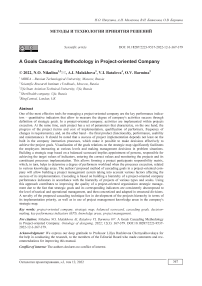A goals cascading methodology in project-oriented company
Автор: Nikulina N.O., Malakhova A.I., Batalova V.I., Barmina O.V.
Журнал: Онтология проектирования @ontology-of-designing
Рубрика: Методы и технологии принятия решений
Статья в выпуске: 3 (45) т.12, 2022 года.
Бесплатный доступ
One of the most effective tools for managing a project-oriented company are the key performance indicators - quantitative indicators that allow to measure the degree of company's activities success through definition of strategic goals. In a project-oriented company, activities are implemented within projects execution. At the same time, each project has a set of parameters that characterize, on the one hand, the progress of the project (terms and cost of implementation, qualification of performers, frequency of changes in requirements), and, on the other hand - the final product (functionality, performance, usability and maintenance). It should be noted that a success of project implementation depends not least on the built in the company interaction processes, which make it possible to make decisions effectively to achieve the project goals. Visualization of the goals relations on the strategic map significantly facilitates the employees interacting at various levels and making management decisions in problem situations. Building a strategic map based on a balanced scorecard implies appointment of persons, responsible for achieving the target values of indicators, entering the correct values and monitoring the projects and its constituent processes implementation. This allows forming a project participants responsibility matrix, which, in turn, helps to determine a degree of performers workload when the processes execution, related to various knowledge areas. The authors' proposed method of cascading goals in a project-oriented company will allow building a project management system taking into account various factors affecting the success of its implementation. Cascading is based on building a hierarchy of a project-oriented company performance indicators in accordance with the hierarchy of projects of various types and scales. Using this approach contributes to improving the quality of a project-oriented organization strategic management due to the fact that strategic goals and its corresponding indicators are consistently decomposed to the level of tactical and operational management, and then concretized and adapted in structural divisions. A novelty of the proposed cascading technique lies in development of the projects hierarchy in terms of its implementation priority, as well as in use of project management knowledge areas in the company's strategic map.
Project-oriented company, strategic map, balanced scorecard, cascading goals, decision-making, key performance indicators (kpi), knowledge areas, project management
Короткий адрес: https://sciup.org/170195765
IDR: 170195765 | DOI: 10.18287/2223-9537-2022-12-3-367-379
Список литературы A goals cascading methodology in project-oriented company
- Archibald R. Management of High-Tech Programs and Projects / Russell D. Archibald; per. from English Ma-montova E.V. [In Russian]. Мoscow: DMK Press; IT co, 2010, 464 p.
- Nikulina NO, Malakhova AI, Batalova VI. Methodology for assessing the contribution of project team members to achieving the goals of the IT project [In Russian]. Information and mathematical technologies in science and management. 2021; 2(22): 94-104. DOI:10.38028/ESI.2021.22.2.010.
- Kon M. Agile. Project evaluation and planning [In Russian]. Мoscow: Alpina Publisher, 2018, 418 p.
- Sutherland J., Scrum. The revolutionary method of project management [In Russian]. Мoscow: Mann, Ivanov and Ferber, 2016, 186 p.
- Guarino N, Giaretta P. Ontologies and Knowledge Bases. Towards a Terminological Clarification. In: Towards Very Large Knowledge Bases. N.J.I. Mars (ed.), IOS Press, Amsterdam, 1995.
- Yerzhenin RV, MasselLV, Ontological approach to the knowledge representation about the methodology of modeling a complex control system [In Russian]. Ontology of designing, 2020; 10(4): 463-476. DOI: 10.18287/22239537-2020-10-4-463-476.
- Gavrilova TA, Kudryavtsev DV, Muromtsev DI. Knowledge Engineering. Models and methods [In Russian]. St. Petersburg: Publishing House "Lan", 2016, 324 p.
- Kaplan R, Norton D. Balances Scoredcard [In Russian]. Moscow: Olimpbusiness, 2003, 342 p.
- Barmina OV, Nikulina NO, Intelligent system for interactive business processes management in project-oriented organizations [In Russian]. Ontology of designing, 2017; 7(1): 48-65. DOI: 10.18287/2223-9537-2017-7-1-48-65.
- Huali Tang, Shoufu Wan, Cong-Cong Li, Haiming Liang, Yucheng Dong. Consensus Reaching Process in the Two-Rank Group Decision-Making with Heterogeneous Preference Information. International Journal of Computational Intelligence Systems, 12 February 2021.
- Xiujuan Ma, Zaiwu Gong, Weiwei Guo, Optimisation of Group Consistency for Incomplete Uncertain Preference Relation. International Journal of Computational Intelligence Systems, 2020; 13(1): 130-141.
- Chernyakhovskaya LR, Malakhova AI, Nikulina NO, Batalova VI. Information and analytical collective decision-making support using intelligent technologies. Journal of Physics: Conference Series, Volume 1864 (2021) 012090, 13th Multiconference on Control Problems (MCCP 2020) 6-8 Oktober 2020. IOP Publishing. DOI: 10.1088/1742-6596/1864/1/012090.
- A guide to the project management body of knowledge (PMBoK), Sixth ed. / Project Management Institute, Inc., 14 Campus Boulevard, Newton Square, Pennsylvania 19073-3299 USA, 2017, 756 p.
- Loeffler M. A Retrospective in Agile. Proven methods and innovative approaches [in Russian]. Moscow: Mann, Ivanov and Ferber, 2020, 336 p.
- Chernyakhovskaya L, Nikulina N, Barmina O. A balanced scorecard forming method for efficiency assessment of the software projects management. Proceedings of the 7th Scientific Conference on Information Technologies for Intelligent Decision Making Support (ITIDS 2019). https://doi.org/10.2991/itids-19.2019.16.
- SWRL: A Semantic Web Rule Language Combining OWL and RuleML. National Research Council of Canada, Network Inference and Stanford University, 2004.
- Phelps C, Heidl R, Wadhwa A. Knowledge, networks, and knowledge networks a review and research agenda. Journal of Management, 2012; 38(4): 1115-1166.
- Alavi M, Leidner DE. Knowledge management systems: issues, challenges, and benefits. Communications of the AIS, 1999; 1(2es): 1-28. DOI:10.17705/1CAIS.00107.
- Lillehagen F, Krogstie J. Active Knowledge Modelling of Enterprises. Springer, 2009, 436 p.
- Maier R, Hadrich T, PeinlR. Enterprise Knowledge Infrastructures: 2nd Edition. Springer, 2010, 460 p.


